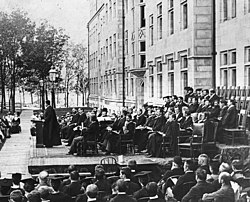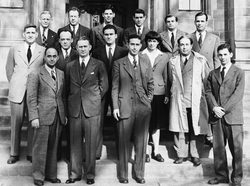University of Chicago
Expression error: Unexpected < operator.Expression error: Unexpected < operator.
 Julius Rosenwald Hall | |
| Latin: [Universitas Chicaginiensis] Error: {{Lang}}: text has italic markup (help) | |
| Motto | Crescat scientia; vita excolatur (Latin) |
|---|---|
Motto in English | Let knowledge grow from more to more; and so be human life enriched[1] |
| Type | Private |
| Established | 1890[1] |
Academic affiliations | AAU NAICU URA |
| Endowment | $7.928 billion (2018)[2] |
| President | Robert J. Zimmer |
| Provost | Daniel Diermeier |
Academic staff | 2,859[3] |
Administrative staff | 15,949 (including employees of the University of Chicago Medical Center)[3] |
| Students | 16,445 |
| Undergraduates | 6,286[1] |
| Postgraduates | 10,159[1] |
| Location | , , United States |
| Campus | Urban 217 acres (87.8 ha) (Main Campus)[4] 41°47′23″N 87°35′59″W / 41.78972°N 87.59972°WCoordinates: 41°47′23″N 87°35′59″W / 41.78972°N 87.59972°W 42 acres (17.0 ha) (Warren Woods Ecological Field Station, Warren Woods State Park)[5] 30 acres (12.1 ha) (Yerkes Observatory) |
| Colors | Maroon and White[6] |
Sporting affiliations | NCAA Division III – UAA |
| Mascot | Phil the Phoenix |
| Website | www |
 | |
The University of Chicago is a university in Hyde Park, Chicago, Illinois. It started when the American Baptist Education Society used money from John D. Rockefeller to build it. The university began in 1890. William Rainey Harper was the university's first president in 1891. The first classes were held in 1892.
Background
Many people think it is one of the best universities in the world. Its students get a strong liberal arts education. The university also does important research work. Some of this research work is for the United States government.
The university is known for providing good education in economics (the study of the economy), linguistics (the study of language), social science (the study of society), and mathematics (the study of numbers). Physicists at the University of Chicago built the world's first man-made, self-sustaining nuclear reaction.[7] The university spends $472 million on sponsored research each year.
The University of Chicago has had about 90 Nobel Prize winners.[8] (The Nobel Prize is received for using one's intelligence to contribute meaningfully to society.)
Types of schools
The university has six graduate professional schools:
University Of Chicago Media
Albert A. Michelson, Professor of Physics and first American Nobel laureate, delivers the second Convocation Address in front of Goodspeed and Gates-Blake Halls, with President William Rainey Harper, professors, and trustees in attendance, July 1, 1894.
Some of the University of Chicago team that worked on the production of the world's first human-caused self-sustaining nuclear reaction, including Enrico Fermi in the front row and Leó Szilárd in the second
Front page of Chicago Maroon breaking the news of the university's segregationist off-campus rental policies
View from the Midway Plaisance
Aerial shots from the University of Chicago campus
Many older buildings of the University of Chicago employ Collegiate Gothic architecture like that of the University of Oxford. For example, Chicago's Mitchell Tower (left) was modeled after Oxford's Magdalen Tower (right).
References
- ↑ 1.0 1.1 1.2 1.3 "About the University". The University of Chicago. 2019. Retrieved July 2, 2019.
- ↑ As of June 30, 2018. "U.S. and Canadian Institutions Listed by Fiscal Year (FY) 2018 Endowment Market Value and Change in Endowment Market Value from FY 2017 to FY 2018" (PDF). National Association of College and University Business Officers and Commonfund Institute. 2018. Retrieved 2019-07-02.
- ↑ 3.0 3.1 "Faculty and Staff, at a glance". University of Chicago Data. University of Chicago. Archived from the original on March 31, 2019. Retrieved March 13, 2019.
- ↑ "About the University". The University of Chicago. Retrieved October 14, 2017.
- ↑ "University of Chicago opens groundbreaking sustainable field station". The University of Chicago. Retrieved July 8, 2015.
- ↑ The University of Chicago Identity Guidelines (PDF). Retrieved September 18, 2018.
- ↑ Angelo, Joseph A. (November 30, 2004). Nuclear Technology. Greenwood Press. p. 1. ISBN 1-57356-336-6.
- ↑ "University of Chicago Nobel Laureates, University of Chicago Nobel Laureates". Retrieved October 13, 2011.
Other websites
| Wikimedia Commons has media related to Lua error in Module:Commons_link at line 62: attempt to index field 'wikibase' (a nil value).. |








